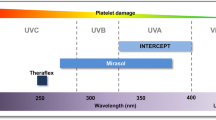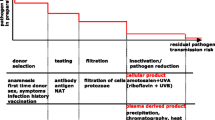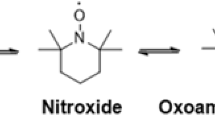Abstract
Riboflavin is a naturally occurring compound and an essential human nutrient. Studies in the 1960s and 70s showed that it could be effective, when exposed to visible or UV light, in inactivating viruses and bacteria [1]. This suggested to us that it could act as a photosensitizer useful in the inactivation of pathogens found in blood products, because of its nucleic acid specificity and its limited tendency toward indiscriminate oxidation. The riboflavin molecule is a planar, conjugated ring structure with a sugar side chain that confers water solubility. The planar portion is capable of intercalating between the bases of DNA or RNA. Light activated riboflavin oxidizes guanine in nucleic acids, preventing replication of the pathogen’s genome [2]. Gambro BCT is developing processes using riboflavin and light to inactivate pathogens in plasma, platelet, and red cell products. We call these Pathogen Eradication Technology (PET) processes. Riboflavin is non-toxic; it must be present in the body for good health. The photo-byproducts formed in the PET processes are lumichrome and protein adducts. The photodegradation of riboflavin in the body is clearly shown by the decrease in its concentration in neonates who are treated with intense visible light to break down circulating bilirubin, which their immature livers cannot yet handle [3]. A definitive lookback study showed no difference in cancer rates between the 55,000 children receiving this therapy in Denmark from 1977 through 1989 and nonirradiated controls [4]. Gambro BCT is developing specific riboflavin-based PET processes for platelet concentrates, fresh frozen plasma, and packed red blood cells. In each, the process is being optimized to achieve high levels of inactivation of specific pathogens, while maintaining acceptable levels of product quality and activity. Extra- and intracellular HIV, BVDV (a model for HCV), and pseudorabies virus (a herpes virus) have been used to guide process development and validation. We have demonstrated 4 to 7 log10 reductions in the titers of these viruses, when they are spiked into blood products and irradiated in the presence of riboflavin. Porcine parvovirus, a tight-capsid, nonenveloped virus is more resistant, a finding in all experimental inactivation approaches. A range of bacteria implicated in platelet and red cell transfusion injuries and deaths, including S. aureus, E. coli, K. pneumoniae, and Y. enterocolitica, are being used to validate antibacterial efficacy. The PET platelet process involves the addition of riboflavin to platelets in plasma, illumination of the product, storage of the product and transfusion without further manipulation. The lack of toxicity of the treatment byproducts permits this ease of use. Quality of the platelets throughout storage has been assessed by pH, P02, lactate, hypotonic shock response, morphology, glucose, and GMP-140 expression. In vitro function is well maintained. The levels seen are within the range of those reported in commonly transfused products. Radiolabeled transfusion studies of treated platelets have been carried out in primates to determine a preliminary measure of their in-vivo circulation. The in vivo recoveries and survivals of treated and control platelets did not differ. This work suggests that an endogenous photosensitizer, riboflavin, which has an extremely good safety profile, can inactivate high levels of a broad range of viruses and bacteria in platelet concentrates, fresh frozen plasma, and in red blood cells, preserving the activity and functionality of the components. Planned animal and clinical studies are expected to solidify this suggestion into a well-characterized process which can be safely and readily applied to reduce the risks of transfusion transmitted disease.
Similar content being viewed by others
References
Vrielink H, Reesink HW. Transfusion-transmissible infections.Current Opinion Hematol. 1998;5:396–405.
Gallarda J, Dragon E. Blood screening by nucleic acid amplification; Current issues, future challenges.Molecular Diagnosis. 2000;5:11–22.
Busch M. HIV, HBV, and HCV. New developments related to transfusion safety.Vox Sang. 2000;78(suppl 2):253–256.
Allain J-P. Genomic screening for blood-borne viruses in transfusion settings.Clin Lab Haem. 2000;22:1–10.
Blajchman MA, Ali AM, Richardson HL. Bacterial contamination of cellular blood components.Vox Sang. 1994;67(suppl 3):25–33.
Ness P, Braine H, King K, et al. Single donor platelets reduce the risk of septic platelet transfusion.Transfusion. 2001; 41:857–861.
Perez P, Rashid Salmi L, Follea G, et al. Determinants of transfusion-associated bacterial contamination: results of the French BACTHEM case-control study.Transfusion. 2001;41:862–872.
Tsugita A, Okada Y, Uchara K Photosensitized inactivation of ribonucleic acids in the presence of riboflavin.Biochim Biophys Acta. 1965;103:360–363.
Douki T, Cadet J. Modification of DNA bases by photosensitized one-electron oxidation.Int J Radiat Biol. 1999;75:571–581.
Goodrich RP. The use of riboflavin for the inactivation of pathogens in blood products.Vox Sang. 2000;78(suppl 2):211–215.
McCormick DB, Innis WSA, Merrill AH, Lee SS. Mammalian metabolism of flavins inFlavins and Flavoproteins, Bray RC, Engel PC, and Mayhew SG, eds. (Walter de Gruyter & Co., Berlin_New Yory, 1984).
Salim-Hanna M, Valenzuela A, Silva E. Riboflavin status and photo-induced riboflavin binding to proteins of the rat ocular lens.Intenat J Vit Nutr Res. 1988;58:61–65.
Sisson TRC. Photodegradation of riboflavin in neonates.Fed Proc. 1987;46:1883–1885.
Speck WT, Rosenkranz HS. Phototherapy for neonatal hyperbilirubinemia a potential environmental health hazard to newborn infants: a review.Environmental mutagenesis. 1979; 1:321–336.
Olsen JH, Hertz H, Kjaer SK, et al. Childhood leukemia following phototherapy for neonatal hyperbilirubinemia (Denmark).Cancer Causes and Control. 1996;7:411–414.
Tay-Goodrich B, Schuyler RJ, Goodrich RP, and Dumont LJ. Evaluation of photochemically treated platelet concentrates in non-human primates.Transfusion. 2000;40(suppl):38S.
Samar BM, Goodrich RP. Viral inactivation in plasma using riboflavin-based technology.Transfusion. 2001;41(suppl):88S.
McAteer MJ, Tay-Goodrich B, Doane S, et al. Photoinactivation of virus in packed red blood cell units using riboflavin andg visible light.Transfusion. 2000;40(suppl):99S.
Author information
Authors and Affiliations
About this article
Cite this article
Corbin, F. Pathogen inactivation of blood components: Current status and introduction of an approach using riboflavin as a photosensitizer. Int J Hematol 76 (Suppl 2), 253–257 (2002). https://doi.org/10.1007/BF03165125
Issue Date:
DOI: https://doi.org/10.1007/BF03165125




